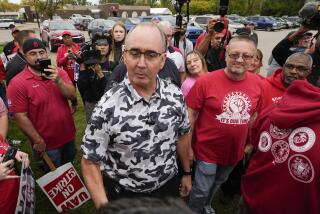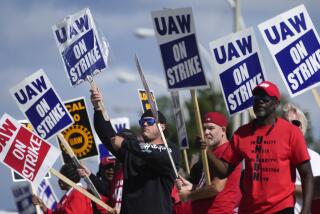United’s Staff Would Have to Wait for Payoff
- Share via
Are the pilots and other employees of United Airlines getting a good deal if, as seems likely, they win the bidding contest for control of UAL Inc., the airline’s holding company?
The answer is yes, they’re getting a pretty good deal. But of course there is risk involved--a big payoff for employees is at least several years away and, meanwhile, there will be cuts in pay and changes in the way they work.
And there are sure to be lots of questions about the role of unions when employees own the company--whether unions would be better off sticking to traditional labor-management collective bargaining and leaving ownership to others, and even whether such traditions are possible in today’s changing world.
United in short is likely to set some important precedents, if the employee’s group’s $6.5-billion offer for UAL stands up.
And that’s not certain just yet. California investor Marvin Davis, who has so far offered $5.9 billion, or $275 a share, for UAL, could come in with a new bid higher than the $300 a share that a group led by the Airline Pilots Assn. offered last week. But even if Davis offers more, it is unlikely that he can buy the airline without the promise of wage and work rule concessions from United’s pilots, machinists and flight attendants.
In fact, says analyst Daniel Hersh of the Los Angeles brokerage Bateman Eichler, Hill Richards, even if Davis got concessions, he still would have trouble doing the deal without the tax advantages of the employee stock ownership plan that the pilots are setting up. Those tax advantages, unavailable to an outside buyer like Davis, make the UAL deal affordable, says Hersh.
So the airline will become the largest employee-owned company in the United States, with its pilots, machinists and flight attendants owning 75% of the stock, British Airways owning 15% and UAL’s current management owning 10%. The managers will continue to manage, but under the supervision of an employee-controlled board of directors.
End of the Rainbow
To pay their share of the buyout, the pilots will put up some of their pension money, and give wage and work rule concessions worth $250 million a year for an undisclosed number of years. That means they will fly more hours per month at the same or lower pay and accept labor-saving advances such as new planes that fly with two people in the cockpit instead of three. United’s other unions, if they agree to the pilots’ proposals, will give $120 million a year in concessions. The idea is that $370 million a year in cost reductions will help United repay the debt that finances the $6.5-billion buyout.
But then, when the debt has been paid down--perhaps five or six years from now--United Airlines will sell stock to the public again and the employees will be able to reap the rewards of ownership. There could be a pot of gold at the end of the rainbow.
That’s the way an employee stock ownership plan is supposed to work, according to Louis Kelso, the San Francisco investment banker who devised the ESOP concept more than 50 years ago. Kelso argued that traditional labor union policies of simply asking for higher wages was self defeating because the workers ended up with no ownership of property and wages depreciated by inflation. In the 1960s and ‘70s, Kelso’s ideas resulted in ESOP tax breaks being written into law.
But ESOPs are not without critics--including investment banker Brian Freeman, who frequently works for labor unions and is representing United’s machinists. Freeman, who is skeptical of the current deal, says of ESOPs in general: “They are almost never good deals for workers. Unions should be concerned with long-term job stability, not ownership.”
A good collective bargaining contract offers the worker more security than ownership, he says. And that may be true, but in today’s world of rapid economic change, national and international, takeovers and mass layoffs, the security of traditional labor-management contracts has been taking a beating--especially in the deregulated airline industry.
In fact, in that industry the most secure employment has been offered by mostly non-union Delta Air Lines. The Atlanta-based carrier has not laid off an employee since the late 1950s. How does Delta do it? Sometimes with common sense. In the 1970s, when air travel fell because of the energy crisis, now-retired Chairman David Garrett asked shareholders to take a lower dividend so loyal employees could keep their jobs.
Then, in the recession of the early 1980s, Delta employees worked at whatever was available rather than be laid off. Unionized pilots loaded baggage; others did extra duty in the marketing department.
The result is that Delta has high labor costs but also a high reputation for service--and it is doing well in all its markets today.
The point for United’s employees is that they should study Delta’s operation because that is the kind of service and flexibility that they will have to bring to United Airlines if they want to earn that pot of gold at the end of the ESOP rainbow.
More to Read
Inside the business of entertainment
The Wide Shot brings you news, analysis and insights on everything from streaming wars to production — and what it all means for the future.
You may occasionally receive promotional content from the Los Angeles Times.










